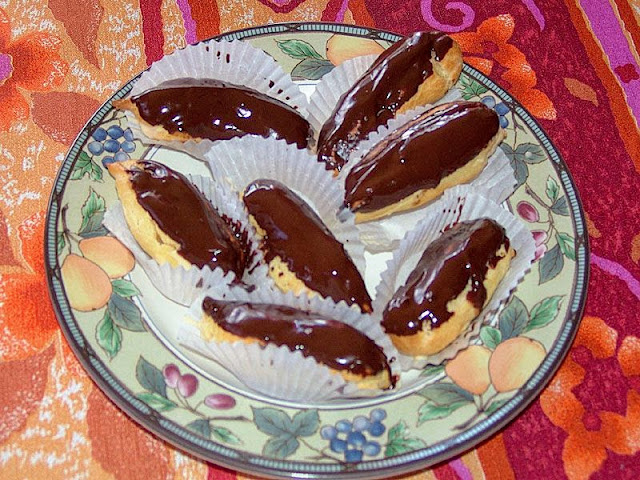
Photo by Geni Certain
My recent post on cannoli elicited some enthusiastic reader response, particularly from Jackipdx. We agreed that while cannoli were great, a well made eclair is a thing of joy.
So, after date and transportation arrangements were emailed, Jacki bused and cabbed out to Rancho Las Cuevas last Sunday. Our friend and neighbor, Geni, was also present to observe, photograph, and especially, sample eclairs.
I called it a "workshop", rather than a "class", as I hadn't made these in many years. There are numerous variables that must be dealt with to get good results. In the end, I'd say we did well, although there were several areas needing improvement.
The following are technical details. You can skip over this if you like and jump directly to the slideshow. -below.
We first made a pastry cream using milk plus evaporated milk (I deemed the cream specified in the recipe would make it too rich.) It's necessary to make the filling first so that it may cool properly before filling the eclair shells.
There was also granulated sugar, cornstarch, egg yolks, a pinch of salt, and vanilla extract.
The recipe was derived from one in Bernard Clayton's Complete Book of Pastry. I thought some of the procedures were illogical, such as putting the vanilla in with the milk, then heating it. Usually, vanilla is added last so its volatiles don't evaporate. I adjusted according to my own experiences in making puddings, pie fillings and pastry creams.
When the cornstarch, mixed with the 4 tempered egg yolks were added to the remaining hot milk, the mixture set up almost instantly. That was very unusual. It could be that 4 yolks have one too many, or it may have been that I'd drawn out too much hot milk for the tempering. The filling was so thick that I added 1/2 cup or more milk to loosen it up a bit. I added a tbsp of butter and the vanilla, and whisked it in.
The hot mixture was emptied into a bowl over an ice water bath so it would cool more quickly. After, a little granulated sugar was sprinkled over to reduce crusting, then plastic film, and all was refrigerated.
After cleaning up the utensils, we proceeded to make the pate a choux, or cream puff paste.
That consisted of bringing to a boil water with a little milk, a stick of butter and a pinch of salt. In all my bakery years, no one ever used milk nor butter in cream puff paste. My opinion is that vegetable shortening results in a firmer and crisper, if less tasty shell. But I went along with it.
The paste looked good as we cooked it to a ball, then placed it in the mixer with the paddle attachment. A few moments of cool down, and we added the 4 whole eggs in 4 increments, incorporating thoroughly after each addition.
We were ready for the Test. Jacki had brought a couple of pastry bags and tips. We set up the bigger bag with a large, metal cone tip, and filled the bag.
We'd prepared the baking sheets by dabbing spots of shortening on, then placing baker's parchment over it. The shortening keeps the paper from shifting around as the paste is extruded onto it.
Bagging out the paste for eclairs is a learned skill which doesn't come easily. Results ranged from so-so to not bad. This really needs a video illustrating the technique. Fortunately, we have a slide show. The little end tips of paste should be pushed back with a moistened finger, not with the pastry bag cone, and after the sheet is filled. Generous spacing is important.
Into a 425º F oven, about 22 minutes, then exchange the two sheets, and 5 minutes more.
The baking sheets are placed on cooling racks, then each eclair shell is pierced with the tip of a skewer to vent steam. This helps prevent sogging.
At this stage, we broke for lunch: a large, composed Salade Niçoise. (Photo by G. Certain), and some pain du campagne, baked earlier that morning. I believe in doing these things in style.
After lunch, we returned to fill and glaze the eclairs. I strained the custard (usually unnecessary) as I'd seen small lumps.
The filling stage is relatively easy, but it's good to fill the shells until they bulge. Handling a pastry bag is just another skill to be learned and practiced.
After some indecision, I decided to make a simple chocolate glaze by melting semi-sweet chocolate and a little butter in the microwave oven. No powdered sugar was necessary, although that can be used.
The filled eclairs are iced/glazed simply by dipping them lightly into the warm icing, then gently removing any excess with a small spatula.
I placed them onto opened cupcake liners on a platter, and they were ready to serve.
Here's the slideshow, which illustrates the entire process in simplified form.
All photos by Geni Certain, copyright 2009.
Addendum










